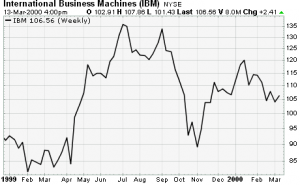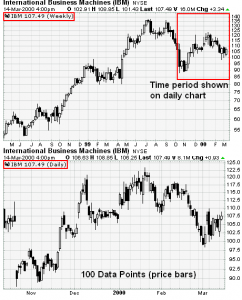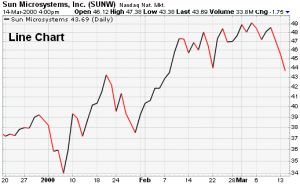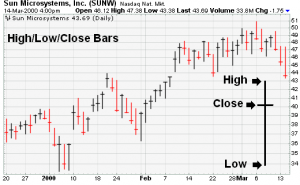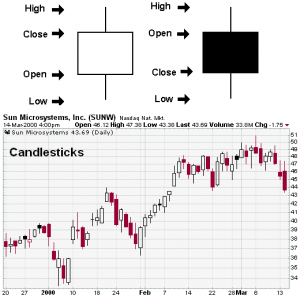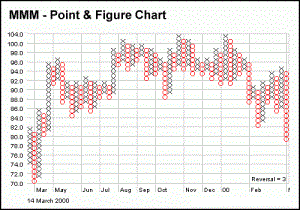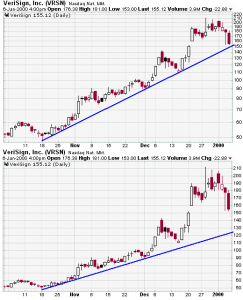What Are Charts?
A price chart is a sequence of prices plotted over a specific time frame. In statistical terms, charts are referred to as time series plots.
On the chart, the y-axis (vertical axis) represents the price scale and the x-axis (horizontal axis) represents the time scale. Prices are plotted from left to right across the x-axis with the most recent plot being the furthest right.
Technicians, technical analysts and chartists use charts to analyze a wide array of securities and forecast future price movements. The word “securities” refers to any negotiable instrument representing financial value. Securities are broadly categorized into debt securities (such as banknotes, bonds and debentures); equity securities, e.g., common stocks; and derivative contracts, such as forwards, futures, options and swaps. The company or other entity issuing the security is called the issuer. A country’s regulatory structure determines what qualifies as a security. For example, private investment pools may have some features of securities, but they may not be registered or regulated as such if they meet various restrictions.any tradable financial instrument or quantifiable index such as stocks, bonds, commodities, futures or market indices. Any security with price data over a period of time can be used to form a chart for analysis.
While technical analysts use charts almost exclusively, the use of charts is not limited to just technical analysis. Because charts provide an easy-to-read graphical representation of a security’s price movement over a specific period of time, they can also be of great benefit to fundamental analysts.
The time frame used for forming a chart depends on the compression of the data: intraday, daily, weekly, monthly, quarterly or annual data.
Daily data is made up of intraday data that has been compressed to show each day as a single data point, or period.
Weekly data is made up of daily data that has been compressed to show each week as a single data point.
*
Traders usually concentrate on charts made up of daily and intraday data to forecast short-term price movements. The shorter the time frame and the less compressed the data is, the more detail that is available.
*
Investors usually focus on weekly and monthly charts to spot long-term trends and forecast long-term price movements. Because long-term charts (typically 1-4 years) cover a longer time frame with compressed data, price movements do not appear as extreme and there is often less noise.
*
Others might use a combination of long-term and short-term charts. Long-term charts are good for analyzing the large picture to get a broad perspective of the historical price action. Once the general picture is analyzed, a daily chart can be used to zoom in on the last few months.
How Are Charts Formed?
there are other methods available, these are 4 of the most popular methods for displaying price data.
Line Chart
Some investors and traders consider the closing level to be more important than the open, high or low. By paying attention to only the close, intraday swings can be ignored. Line charts are also used when open, high and low data points are not available. Sometimes only closing data are available for certain indices, thinly traded stocks and intraday prices.
Bar Chart
Perhaps the most popular charting method is the bar chart. The high, low and close are required to form the price plot for each period of a bar chart. The high and low are represented by the top and bottom of the vertical bar and the close is the short horizontal line crossing the vertical bar. On a daily chart, each bar represents the high, low and close for a particular day. Weekly charts would have a bar for each week based on Friday’s close and the high and low for that week.
Bar charts can also be displayed using the open, high, low and close. The only difference is the addition of the open price, which is displayed as a short horizontal line extending to the left of the bar. Whether or not a bar chart includes the open depends on the data available.
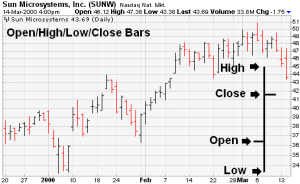
Candlestick Chart
Originating in Japan over 300 years ago, candlestick charts have become quite popular in recent years. For a candlestick chart, the open, high, low and close are all required. A daily candlestick is based on the open price, the intraday high and low, and the close. A weekly candlestick is based on Monday’s open, the weekly high-low range and Friday’s close.
Many traders and investors believe that candlestick charts are easy to read, especially the relationship between the open and the close. White (clear) candlesticks form when the close is higher than the open and black (solid) candlesticks form when the close is lower than the open. The white and black portion formed from the open and close is called the body (white body or black body). The lines above and below are called shadows and represent the high and low.
Point & Figure Chart
The charting methods shown above, all, plot one data point for each period of time. No matter how much price movement, each day or week represented is one point, bar, or candlestick along the time scale. Even if the price is unchanged from day to day or week to week, a dot, bar, or candlestick is plotted to mark the price action. Contrary to this methodology, point & figure Charts are based solely on price movement, and do not take time into consideration. There is an x-axis but it does not extend evenly across the chart.
The beauty of point & figure charts is their simplicity. Little or no price movement is deemed irrelevant and therefore not duplicated on the chart. Only price movements that exceed specified levels are recorded. This focus on price movement makes it easier to identify support and resistance levels, bullish breakouts and bearish breakdowns. This P&F article has a more detailed explanation of point & figure charts.
Price Scaling
There are two methods for displaying the price scale along the y-axis: arithmetic and logarithmic.
An arithmetic scale displays 10 points (or dollars) as the same vertical distance no matter what the price level. Each unit of measure is the same throughout the entire scale. If a stock advances from 10 to 80 over a 6-month period, the move from 10 to 20 will appear to be the same distance as the move from 70 to 80. Even though this move is the same in absolute terms, it is not the same in percentage terms.
A logarithmic scale measures price movements in percentage terms. An advance from 10 to 20 would represent an increase of 100%. An advance from 20 to 40 would also be 100%, as would an advance from 40 to 80. All three of these advances would appear as the same vertical distance on a logarithmic scale. Most charting programs refer to the logarithmic scale as a semi-log scale, because the time axis is still displayed arithmetically.
The chart above uses the 4th-Quarter performance of VeriSign to illustrate the difference in scaling. On the semi-log scale, the distance between 50 and 100 is the same as the distance between 100 and 200. However, on the arithmetic scale, the distance between 100 and 200 is significantly greater than the distance between 50 and 100.
Key points on the benefits of arithmetic and semi-log scales:
*
Arithmetic scales are useful when the price range is confined within a relatively tight range.
*
Arithmetic scales are useful for short-term charts and trading. Price movements (particularly for stocks) are shown in absolute dollar terms and reflect movements dollar for dollar.
*
Semi-log scales are useful when the price has moved significantly, be it over a short or extended time frame
*
Trend lines tend to match lows better on semi-log scales.
*
Semi-log scales are useful for long-term charts to gauge the percentage movements over a long period of time. Large movements are put into perspective.
*
Stocks and many other securities are judged in relative terms through the use of ratios such as PE, Price/Revenues and Price/Book. With this in mind, it also makes sense to analyze price movements in percentage terms.
The keys to successful chart analysis are dedication, focus, and consistency:
*
Dedication: Learn the basics of chart analysis, apply your knowledge on a regular basis, and continue your development.
*
Focus: Limit the number of charts, indicators and methods you use. Learn how to use them, and learn how to use them well.
: Maintain your charts on a regular basis and study them often (daily if possible).
